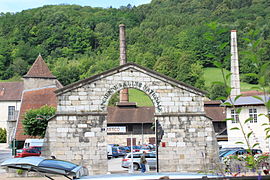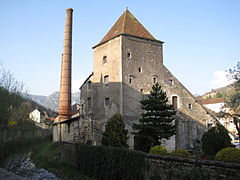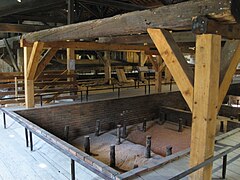Great salt works of Salins-les-Bains
| Great Saltworks of Salins-les-Bains and the Royal Saltworks of Arc-et-Senans | |
|---|---|
|
UNESCO world heritage |
|
|
|
|
| Great salt works of Salins-les-Bains |
|
| National territory: |
|
| Type: | Culture |
| Criteria : | (i) (ii) (iv) |
| Surface: | 10.48 hectares |
| Buffer zone: | 797.18 ha |
| Reference No .: | 203bis |
| UNESCO region : | Europe and North America |
| History of enrollment | |
| Enrollment: | 1982 ( session 6 ) |
| Extension: | 2009 |
The Great Saltworks of Salins-les-Bains was declared a World Heritage Site by UNESCO in 2009, as an extension of the Royal Saltworks in Arc-et-Senans, which was named in 1982 .
The great saltworks was a town in the town of Salins-les-Bains , with its own city wall , its own residential buildings, its own jurisdiction and administration, and its own church. It was located between the northern district of Bourg-Dessous with the Saint Maurice church and the southern district with the Saint-Anatoile church.
history
The urban area was already settled in Celtic times. There were fortifications on the mountains. The inhabitants of the settlement lived from trade with inner Gaul and Italy and from the income from salt production. A high population is likely, some researchers see in Salins the Gallic oppidum Alesia , described by Caesar , in which the Gallic troops were defeated by the Romans . Then the area was assigned to the Roman Empire and the province of Germania superior with the capital Mogontiacum . The exploitation of the saline springs continued under Roman rule. In 523 the settlement was first mentioned as a Salinarum and the salt industry was first mentioned in a document.
Around the year 1000, today's city has two owners: the northern part belongs to the Count of Burgundy , the southern part of the city with the salt pans belonged to the Sire de Salins. In the 13th century , one of these gentlemen, Jean de Chalon the Elder , gained great power in Burgundy. Since he could build on the income from the salt springs , he had a special financial position. In 1249 he granted the city of Salins extensive freedom. The fortifications were reinforced, castles were built to protect the salt works and churches were built. Salins became the economic center of Bourgogne-Franche-Comté and with 5700 inhabitants in the 17th century the second largest town in the country. This even surpassed the then capital Dole .
This prosperity lasted until the annexation of Franche-Comté by the Kingdom of France in 1674. The city lost its leading position as Besançon became the capital of the centralized province. The salt industry in Salins has been modernized and expanded. Claude-Nicolas Ledoux built another salt works in the forest of Chaux , 21 kilometers from Salins, which was operated with the brine from Salins. These production sites were also protected by new fortifications and a garrison . The city of Salins received the title of Place de guerre . Due to the economic development, the population rose to over 8,000 by 1789.
With the revolution that broke out that year , Salins' economic decline began. When the new departments were introduced, however, the smaller Lons-le-Saunier to the south was given the status of capital. Salins, which is remote in the new Jura department , became the seat of the canton. In 1825 the entire southern part of the city burned down and the reconstruction took years.
At the same time, the salt industry generated less profit because it could be produced more cheaply elsewhere. As in other salt cities, the city fathers tried to market the healing properties of the brine . Salins was developed into a spa town , which in 1857 received a direct rail connection to Paris. With the end of the French Empire in 1871, the promotion of the spa by members of the imperial family ended.
In 1962 the saltworks was closed and the number of spa guests decreased. So the number of inhabitants has fallen below 2800 people to date.
The great saltworks
The saltworks were first mentioned in 791 in a document from the Flavigny monastery , although at that time it had probably been exploited for centuries. In the Middle Ages, salt was known as “white gold”, and salt production and trade made enormous profits. The town's salt springs were made more accessible through underground tunnels as early as the 13th century. Additional wells were also drilled.
After the annexation to France, the salt springs and their facilities became state property in the 17th century. Various companies leased the facilities. From the 18th century, the brine obtained could be pumped upwards with the help of the water power of the Furieuse river. Until then, this was done with mere muscle power. In the above-ground production facilities, the brine was boiled in huge pans for 12-18 hours until the water had evaporated and the salt could be formed into balls to dry.
Over time, however, better and cheaper production methods were developed, so that the Saline of Salins could no longer be operated profitably. In addition, wood was needed as fuel for boiling, which the forests around Salins could no longer supply. Part of the production was relocated to Chaux as early as the 18th century, where the large forest of Forêt de Chaux could be exploited. The supply of coal also proved uneconomical.
Investments
Due to several fires and demolitions, the Great Saltworks, formerly a city within the city, is no longer completely preserved. From the fort you can still see some sections of the wall, two towers and the main gate. The building still contains the director's house (today the casino), a production hall with salt pans ( museum ) and an outbuilding (tourist information). The underground tunnels from the 13th century with their Romanesque arches are completely preserved. The technical equipment such as the pump, the sewage system for salty water ( brine ) and fresh water (to drive the pump) are also shown. The remaining area has been converted into green spaces.
traffic
Salins-les-Bains is on the D 472, which crosses the urban area. The N83 , which connects Lyon with Strasbourg , runs about seven kilometers to the west . Salins no longer has its own train station and is served by an SNCF bus line. The Mouchard train station , which is also served by the TGV , is eight kilometers away . Paris can be reached from there in two hours.
literature
- Moulun, Maurice: Les Salines de Salins-les-Bains , Salins-les-Bains o.J.
- Coindre, Gaston (et al.): Salins-les-Bains . Saint-Anatoile, Salins-les-Bains o.J.
- Brabis, David (Red.): Burgundy. French law , Karlsruhe 2004, ISBN 2-06-000230-3
Web links
Coordinates: 46 ° 56 ′ 17 ″ N , 5 ° 52 ′ 32 ″ E

















